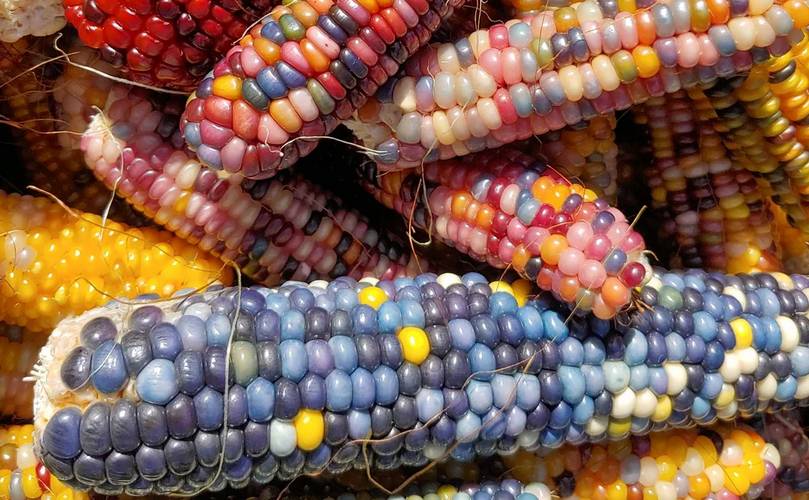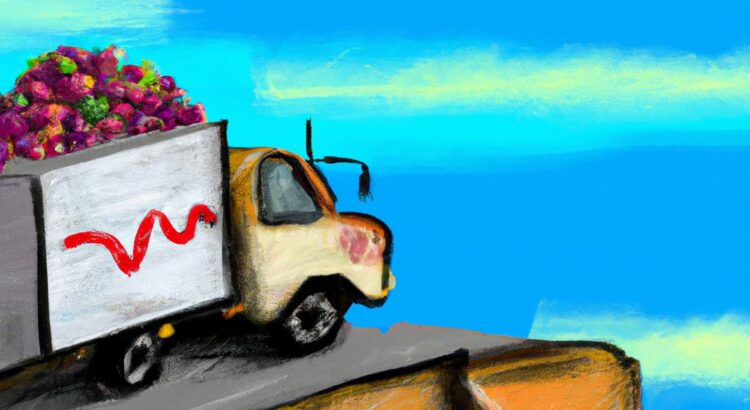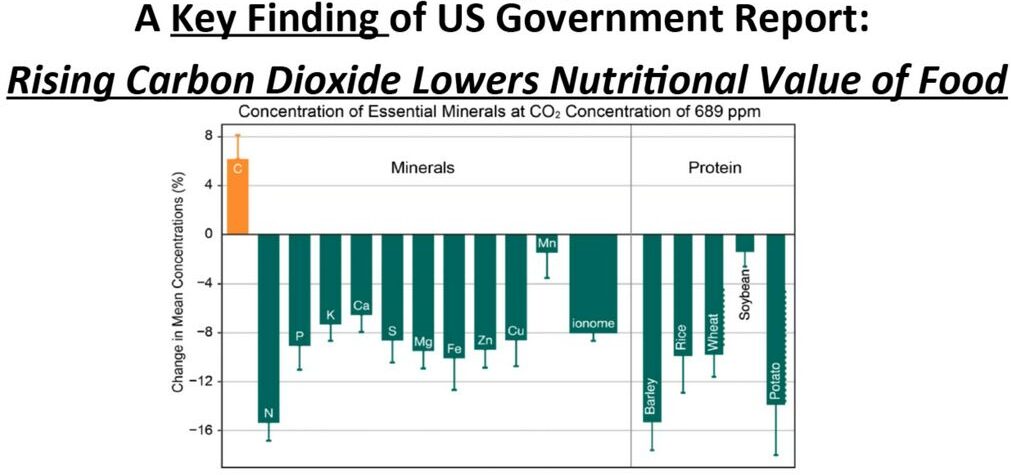The phrase “Great Nutrient Collapse” refers to the ever-decreasing nutrient density of plant matter, and specifically – the plants we use in human diets across the world. There have been a lot of theories and experiments revolving around these questions:
- Why is this happening and at what rate?
- Exactly what nutrients are being “lost” and what are they substituted with?
- What is the actual short-term and long-term impact on lifeforms feeding on the nutrient-depleted plant matter.
Some background and history on those theories would be useful to review before discussing this very disturbing trend.
Background
It’s been more than 20 years since mathematician Irakli Loladze and a team of researchers published their first research paper describing how zooplankton growth and survival was drastically reduced by letting them eat “junk algae” – algae that had more available light and grew faster than the control group of the experiment. The theory was that this light-fed algae contained lower concentrations of non-carbon nutrients while still packing in a lot of calories.
After that paper was published, a quiet storm of new ideas started brewing around the impact of nutrient density on humans and animals that fed on plant matter. One of the factors that led to the nutrient reduction in the first place was already observed – light. But another one that became increasingly troublesome since the start of the industrial revolution is the concentration of atmospheric CO2.
Carbon dioxide is the main material input into the assembly line of photosynthesis. Apart from plants and microorganisms like green algae buffering all of this extra carbon we are emitting, there is also a well-researched phenomenon of oceans absorbing the extra CO2. It’s a process named “ocean acidification” and we won’t be discussing it any further.
The ratio of CO2 absorption by plants compared to the absorption by the oceans hasn’t been researched and discovered, at least to my knowledge. From here we will only focus on what we do know – that the buffering of this extra CO2 has a measurable impact on plant life, most importantly the plant life we and all of the animals on earth depend on for sustenance.
The Famous Politico Article Revisited
I’ve personally first heard of this phenomenon around 2017 in a Politico article by reporter Helena Bottemiller Evich. At that time I was merely a freshly graduated Agricultural engineer with a Master’s degree in the field of soil amelioration sciences.
My degree did little to educate me on what Irakli Loladze and his associates have been studying and the negative impacts of CO2 on plant nutrient density. In fact, the most entrenched opinion in academia and agricultural practice was that pumping carbon dioxide into greenhouses to boost plant yield was a positive (albeit somewhat expensive) technological solution, encouraged by many industry professionals. I’ve personally seen one such system on my professor’s farm.
It was said to boost plant vigor and give an edge to growers who could increase yields significantly, compared to relying only on regular CO2 levels.
Fundamental Implications
- The effect is global as the data for his study was pulled from across the world and controlling for location, elevation, or wild vs. cultivated crops didn’t shift any of the numbers upwards. The correlation between the decline in nutrient density and the rise of CO2 levels was real.
- The plants don’t seem to mind which doesn’t surprise me at all. Plants and other photosynthesis lifeforms have been around way longer than mammals. The Earth has gone through many stages of different atmospheric conditions and yet enzymes like Rubisco are here to stay seemingly throughout all of them, and into the future.
- The seemingly small shifts in minerals that are already depleted from soils due to poor agricultural practices shouldn’t be overlooked. Searching for a singular factor to blame on poor food quality will likely lead nowhere. These negative effects synergize and compound with each other.
- It’s not just that the food contains lower mineral content, it also contains more carbon compounds like sugar. In an already sugar-dominated world, the last thing we need is an added teaspoon of sugar to every meal we prepare.
Impacts on Academia & Society
The author of the original Politico article had noted that back then (in 2017), most of the agricultural and nutritional parts of the scientific community hadn’t even heard about these findings.
I had finished my studies in 2017 and not a single faculty person had mentioned anything regarding these new findings. Fast-forward to 2018, and the popular YouTube education channel Veritasium released an exceptional introduction video on the topic of The Nutrient Collapse, reaching an audience of millions. The author went to great lengths to produce a well-rounded informative video, citing the same 2004 landmark study on the nutrient collapse that Politico had mentioned a year earlier.
After that, in November of 2018, Loladze held a TEDx talk in Bratislava talking about all of this in more detail, and even presenting his equations. I highly recommend you watch it if you’re interested to learn more about this topic.
The amazing thing about being a mathematician is that even though he was rejected every time he submitted a grant proposal for a large-scale study to test this, he was still able to produce a study. A meta-analysis study, but a study nonetheless. It took 10 years since the publication of the 2004 study, but he collected enough data for the meta-analysis.
Thoughts
Agricultural production hasn’t always been so disconnected from the consumer. People had produced and preserved food for themselves and the excess was left for trading. As urbanization and agriculture advanced, we carefully selected more productive and resilient cultivars and spread their seeds to neighboring areas. But we didn’t stop there.
It’s no secret that today, many of these aspects have been evolved, magnified and taken to the very edge of the extremes. Here are some things to keep in mind before starting to search for a solution:
- The people who produce crops today eat as low as 0% of the food they produce for sale but they end up feeding 90+% of the population with that same food. Farmers don’t even have control over prices, big corporations are squeezing out smaller farmers and cornering markets left and right. They are imposing their own production processes, their own cultivars and hybrids, their own pesticides. Nowhere is this more obvious than the production of grain crops, but tomatoes and bananas are also great examples.
- Food is being sold by the pound, with a huge portion of the population completely overlooking the topic of product quality. At agricultural colleges, professors teach us that we need to return to the soil what we’ve taken, or otherwise let it replenish its available nutrients over time. In practice, micronutrients are often overlooked since they are needed to improve the plants’ immunity to pests or finish their life cycle by producing viable healthy seeds. Newer cultivars and hybrids combined with pesticides can reduce the need for these micronutrients. We protect plants with chemicals and adequate timing of those chemical applications. For some crops, thinking about plants’ health at the final stages of their lifecycle isn’t necessary at all.
- We have chosen plants that can survive and grow in harsher conditions, lower quality irrigation water, dryer climates, depleted soils, near-zero ecosystem diversity, extreme heat/cold conditions and more. Staying hardy in these conditions is tough so when the plants inevitably start to fail and get attacked by pests, we protect them with pesticides. We end up eating weaker and poorer plants that also grew faster and didn’t have time to uptake enough micronutrients.
What Can The Consumers Do?
This section will be discussing individual-based solutions to the problem of a global nutrient collapse, and sharing these solutions is the major reason for writing this article in the first place.
Since the problem is global and probably not going to be reversed in the near future, it’s safe to say that the next generation will need a set of tools to handle this obvious threat to human wellness.
Sourcing Food & Ingredients
After presenting all of the above, we have to mention some hard truths that everyone who cares for their own health needs to adapt to sooner rather than later.
First: we have to realize that most people will remain slaves to whatever is available in front of them in regards to food produce. If we enter a supermarket and there are 30 bags of different snacks to choose from, we are on average more likely to pick one of those at least once in a while, instead of picking fresh fruits and healthy heirloom vegetables. If, instead, we go to the local market and buy from local and organic farmers – we will automatically eliminate 99% of ultra-processed foods from our diets.
Being smart about the location where we buy products is already a massive step forward. But the price for this would be convenience – something only the humbled are willing to give up. We usually start thinking about these things only once we’ve suffered enough consequences to our health, and only if we are able to trace back our health problems to their source – the local supermarket.
Second: we have to realize that we’ve been conditioned to buy food that looks perfect and lasts longer. We need to learn to separate the appearance of the food product from its nutritional and safety profile. Once you take a bite of a weird-looking heirloom frut grown out of someone’s back yard, you’ll know exactly what we mean by this.
Third: food ingredients are in most cases priced by weight. Weight has always been the primary dimension through which we are charged for food which makes sense historically. However, judging whether a purchase is good or not solely based on price per unit of weight is not a good way to estimate the actual value of a food product nowadays. Buying nutritionally denser foods will automatically make us less hungry and less likely to overeat in the first place, so that is a big factor to keep in mind.

Are Dietary Supplements The Solution?
There is a very good reason for the surge of purchases in the supplements department during the recent pandemic. We are finding out just how weak we’ve gotten and probably one of the easiest (albeit sometimes expensive) ways to cover for dietary insufficiencies is just using supplements.
Supplements most definitely are not the solution, but some of them may be a solution to certain types of inadequate diets. We won’t go into all of the reasons here, but several key criteria to keep in mind are:
- How certain supplements are synthesized in the lab, and the difference between synthesized and naturally-occurring compounds.
- Dosage and timing,
- Shelf life,
- Quality control,
- Price and availability.
If a supplement doesn’t provide quality characteristics in all these areas, it will certainly not be a good long-term solution. For chronic deficiencies, any doctor would say this is a must-have tool to get back into good shape.
Cultural Changes: Embracing New (old) Ways of Living!
Respect for heritage and adherence to tradition is something that individualist societies such as many from the developed western world have lost along the path of economic, and cultural development. We have gained much through these civilizational advances, but at a very high cost that is now coming back to haunt us. What exactly are we doing wrong and how can we fix it?
The educational system is simply not designed to teach people how to leverage the rules of the world in their favor. If we look at the definition of the word “leverage” as a verb, it means “to use (something) to maximum advantage.” We are mostly taught by people who work hard, so the lessons we get boil down to managing how to work harder without burning out. There is almost no focus on how we can multiply the results of our efforts by acting smart instead of working hard.
If you are living in a city, far away from actual farmers, use every tool in your arsenal to connect to people who can either get you what you need or tell you where you can get what you need. Don’t think that just because you are surrounded by supermarkets, your only choice is a supermarket. And don’t forget that communication is an actual superpower.
Another great idea comes from East Asian cultures. Take Koreans for example. I was quite surprised to learn that Korean citizens traveling outside of Korea either as immigrants or temporary workers often bring their own seeds from their country and nurture those plants in pots if they live in apartments. This is something no westerner would ever do if they are to travel to another country for any length of time.
The Koreans bring with them many different types of plants: water parsley (minari), aster scaber, chives, shepherd’s purse, and more. They plant sesame seeds and eat the leaves from which they make many different (and quite tasty) dishes. Most of the plants are either for flavor or just supplemental greens. The staple food for them would always remain rice, which can be found anywhere. Various meats are also going to be available in the destination country, so there’s no worries there, and they can make all their traditional recipes.
Be careful when doing this, because you don’t want to bring invasive species and you’d have to check if it’s legal to bring in foreign seeds. In this way, you can also have more control over what food produce is available to you at any time, and with access to even a small garden, you can expand your options to much more than just leafy plants. So, let’s learn something from the Koreans!
Culture, environment and tradition has a huge impact on the day-to-day decisions we make, as well as what ideas come to mind when we’re trying to find solutions to problems.
If you are not a part of a community that would encourage you to at least grow your own basil in a pot, we strongly suggest you join one and have some fun growing plants. You might not get it right the first time, but it’s a very hands-off side activity once you get the hang of it.
Of course, nurturing your own plants is never a be-all end-all solution, but even a small change can make a huge impact on your diet and health. It also opens a door for anyone to expand and optimize production later, if the opportunity presents itself.
Eating Less?
Recently, fasting and intermittent fasting (time-restricted eating) have become hot topics and practices with almost all high-level Silicon Valley executives. They might be applying it en masse, but they certainly didn’t invent it. Some form of fasting or food restriction has been a long-standing practice in almost all religions globally, for thousands of years.
We’ve already talked about sourcing the right kinds of foods, and to make up for the higher price tag, we have fasting as an extra tool to help us get more out of it, for free. A paradox, yes, but it works. It does require quite a bit of education to extract the most value out of fasting, time-restricted eating and caloric restriction without the negative side-effects such as blood sugar drops, low sodium levels, low energy, and binge eating upon refeeding.
Education
No matter which route you pick, the first step would probably be to find the correct information and that is the purpose of this website. Don’t hesitate to reach if you have an idea on how you can help yourself but need advice or directions to the next steps of your journey.
The future is not that grim yet, so don’t worry. There are many communities you can join, both locally and online, to get you started on your journey.
Additional Resources
https://pubmed.ncbi.nlm.nih.gov/15637215/
https://sites.google.com/site/loladze/elevated-CO2-alterns-crop-and-plant-quality

